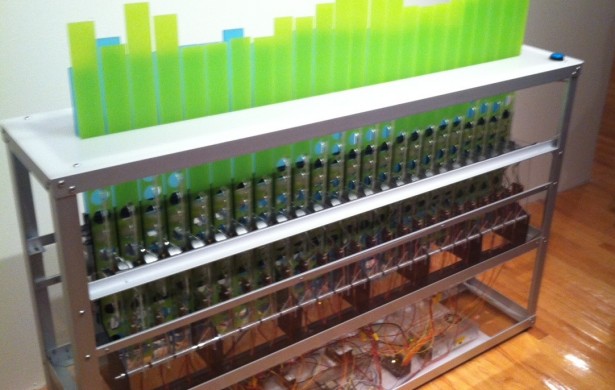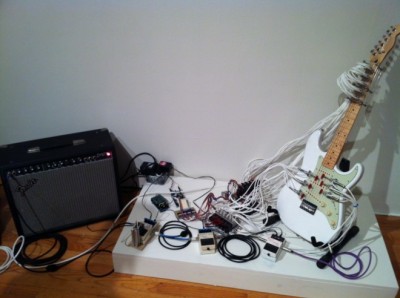
“Machinations” is more than an art show. The exhibition at Columbia College’s Glass Curtain Gallery showcases interactive kinetic machines, a Research Lab and a DIYLILCNC machine, an open-source design for a computer numerical control milling machine invented by a faculty member. Some pieces in the show function as traditional art objects while others invite viewers to experience, learn and participate in the technology.
Artist Theo Jansen is best known for his large “beasts,” wooden machines with intricate lattice construction that make gestural animal motions powered by the wind. On display at “Machinations” are Jansen’s “miniature beasts” assembly kits, a smaller version of his larger sculptures that allow any viewer to acquire art (they can be purchased on his website for $75) and study the inner workings of Jansen’s complex construction.
Joseph Morris’s meditative sculptures contrast Jansen’s participatory approach. Instead of offering his work as a product, he creates discrete sculptures in which the mechanics are exposed to the viewer. His three sculptures “Current Tension” (2012), “Paper Clips” (2009), and “Excuse Me” (2009), show the potential for kinetic motion in modest materials including plastic sheeting, paper clips, and a ¾ inch wheel respectively. “Current Tension,” is particularly poetic, mimicking the cycle of a human breath; at the end of every exhale a plastic ‘lung’ lifts a little, creating an uncanny human posture.
Anat Pollack’s “Flora and Fauna Quantum Populi” (2012) is one of several playful machines made by hacking mechanical toys. It features a luminous centerpiece clumsily constructed with kitschy materials from a tween’s bedroom: a small cymbal, plastic glowing fiber optics and red light bulbs protruding from an acrylic lamp base. A collection of battery-controlled toys wired to respond to the viewer’s presence crawl around the glowing sculpture.

“(Self-Playing) Guitar” (2012), by Jeremy Boyle, stands out as an exceptional use of a readymade object. Using pneumatics, guitar pedals and an amp, Boyle constructed a self-playing guitar. In contrast to player pianos that use a punch card program, Boyle coaxes the guitar to play through mimicked human movements, pressing the frets, strumming the strings. But Boyle also shows a robot’s limitations in attempting to creating art (in this case music); it repeats faithfully but never creates an original variation.
The most technologically seductive piece in the show is Stephen Cartwright’s “Deviation” (2012). A massive contraption of mechanical parts and wires in a clear acrylic case displays double-layered moving Plexiglas bar graphs comparing the time Cartwright woke up to the time the sun rose that same day. The rising and falling candy-colored display attracts the eye immediately but once the source of the data is revealed there is little room for imagination or interpretation.
At the Research Lab, set up in a black box room, visitors can read Make Magazine, books on an Arduino board (an open-source computing platform) and watch a video by kinetic sculptor Arthur Ganson. The experimental space gives the viewer the tools to become hackers, builders, DIYers on their own and contribute to the dialogue. The space elevates the role of education in “Machinations,” using the art gallery as an open-source site where information and knowledge can be shared among the participants.
The question at the heart of the show is how non-proprietary knowledge sharing functions within the current climate of capitalist production and distribution. What do the ideas of open-source promise, and what do they deliver? Can artist, engineers, hobbyists, and citizens be liberated by possessing the means to control our own devices? “Machinations” offers an optimistic outlook. Through multiple means – art, education, participation – there is potential to change our cultural paradigm. Rather than create for profit or consumption, the curators present an economy that relies on contributing to a larger community to increase the collective knowledge.







